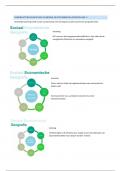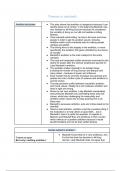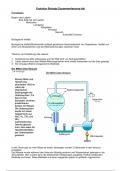FOUNDATIONS OF FINANCE CORNELL NOTES
WEEK 1
Time value of money – Need some way of quantifying the fact that people need to be rewarded for
the basic problem giving up access to their money during the life of an investment.
Rule 1 of comparing cash It is only possible to compare or combine values at the same point in time
flows
Rule 2 of comparing To move a cash flow forward in time, we must compound it (at the
cashflows appropriate rate).
Define compounding Compounding is when we increase the value of a cash flow as we take it
forward into the future, to account for its anticipated growth.
Future value formula
Rule 3 of comparing To move a cash flow back in time, we must discount it back at the
cashflows appropriate rate.
Define discounting Discounting is when we decrease the value of a future cash flow as we work
out what it is worth in the present, to take account of the fact that we have
to wait for it.
Forward vs backwards in Forward → use interest rate to calculate future values of current cashflows
time Backward → use discount rate to calculate present value of future
cashflows
Present value formula
Discount factor Moves a cash flow back from a distinct future time point back to the
present.
Discount factor r is the discount rate
calculation
If the discount rate is The Discount Factor is always less than 1 but greater than 0, provided that n
positive (r > 0) is not zero.
If the discount rate is The Discount Factor will be greater than 1.
negative (r < 0)
If n = 0 The cashflow takes place in the present, the Discount Factor =1, whatever
the Discount Rate is.
Present value of a series Each future cashflow needs to be discounted back a different number of
of cash flows periods. Need to discount each cash flow by a different discount factor.
NPV: the problem In any financial project or instrument, we have cash inflows and outflows
arriving at different times.
What is the NPV The (NPV) of an investment is the sum of all Present Values of all inflows
and outflows.
, The NPV tells us whether an investment is advantageous, once we have
accounted for the Time Value of Money.
Positive vs negative NPV Positive → good, investment is favourable
Negative → bad, investment is unfavourable
What is a perpetuity A stream of equal cashflows that occur at regular intervals and lasts forever
CASH FLOWS START AT t=1
PV formula
Growing perpetuity Is a stream of cash flows that occur at regular intervals which grows at
constant rate (g) forever, after the first cash flow:
Forula for PV of growing This formula works only when g < r , to
perpetuity ensure a finite sum.
Constant annuity A stream of N equal cash flows paid at regular intervals.
-Number of payments is fixed
-Cash flows start at t=1
PV of annuity when t=0
PV annuity when t=N
Mortgages A fixed-rate mortgage or loan is a constant annuity:
Time t = 0: you borrow the Present Value of the annuity
Time t = 1 to t = N: you repay a constant monthly mortgage (or loan)
payment C.
Growing annuity A fixed number of N growing cash flows paid at regular intervals, starting
with a cashflow of C at time t=1, and growing afterwards each period by a
factor of g.
Formula for growing Works even when g>r
annuity
WEEK 2
As N→ ∞ We obtain growing perpetuities formula
As g→0 Obtain constant perpeuity foruma
What is the profitability The discount rate that we use to assess it
of an investment project
strongly dependant on
Incremental earnings We should only examine the way in which future earnings will change as a
result of undertaking the investment project.
-We should consider the earnings we are losing out on, by not pursuing
other, alternative projects.
What to include in NPV / -Any cash inflows which will arise as a direct result of the project
IRR calculations -Any cash outflows in the future which will arise as a direct result of the
project, including any extra tax
-Opportunity cost
, -Any future purchases which will be reduced in magnitude as a result of the
project – this is a benefit / gain of the project.
-The effect of the project on the cash flows of existing projects
(cannibalization).
What should we exclude Sunk or fixed costs that are independent of the investment decision and
from NPV / IRR cannot be recovered.
calculations
Cannibalisation Cannibalisation is where a new investment project decreases some of the
sales (and also, some of the costs) of an existing business.
-We lose some sales, because the new investment project takes customers
away from buying the existing product. This reduces sales.
Effect of cannibalisation Each time our new investment project results in a lost sale of an older
on variable costs product, the older product’s Cost of Goods Sold is reduced, as they are
making less of it. This therefore reduces the company’s Cost of Goods Sold.
Internal rate of return The discount rate for which the Net Present Value of an investment = 0.
(IRR) -We change the value of r until the NPV becomes zero.
Opportunity cost of Inside a company, the company’s discount rate r is sometimes known as its
capital Opportunity Cost of Capital, and it is a measure of how expensive it is for the
company to raise money from investors.
IRR based decision rule Take any investment opportunity where the IRR exceeds the Opportunity
Cost of Capital, and reject any investment opportunity where the IRR is less
than the Opportunity Cost of Capital.
If IRR > r , then we accept the project
If IRR < r , then we reject the project
Cases in which IRR and -Delayed investments
NPV disagree -Non-existent IRR
-Multiple IRRs
We should always use the NPV rule.
The payback rule States that you should only accept a project if its cash flows repay its initial
investment within a prespecified period.
Why is the payback rule 1. Ignores the project’s cost of capital and the time value of money;
less reliable than NPV 2. Ignores the cash flows after the payback period;
3. Relies on an ad-hoc decision criterion (the choice of payback period).
Delayed investment Fallacy derives from the fact that the first cash flow is an inflow rather than
fallacy an outflow
-So IRR rule would wrongly advise us to accept the offer
Multiple IRRs fallacy Graph will cross horizontal axis in two places, so there’s 2 solutions where
NPV = 0
Means project has two IRRs
- There may be as many IRRs as the number of sign changes in the cash flow
stream
No solution In some cases the graph doesn’t cross the horizontal axis, so IRR is undefined
Mutually exclusive Businesses have to choose among mutually exclusive projects: Investing in
projects one project necessarily excludes the other.
Decision rules:
-NPV rule: Choose the project with the highest NPV.
WEEK 1
Time value of money – Need some way of quantifying the fact that people need to be rewarded for
the basic problem giving up access to their money during the life of an investment.
Rule 1 of comparing cash It is only possible to compare or combine values at the same point in time
flows
Rule 2 of comparing To move a cash flow forward in time, we must compound it (at the
cashflows appropriate rate).
Define compounding Compounding is when we increase the value of a cash flow as we take it
forward into the future, to account for its anticipated growth.
Future value formula
Rule 3 of comparing To move a cash flow back in time, we must discount it back at the
cashflows appropriate rate.
Define discounting Discounting is when we decrease the value of a future cash flow as we work
out what it is worth in the present, to take account of the fact that we have
to wait for it.
Forward vs backwards in Forward → use interest rate to calculate future values of current cashflows
time Backward → use discount rate to calculate present value of future
cashflows
Present value formula
Discount factor Moves a cash flow back from a distinct future time point back to the
present.
Discount factor r is the discount rate
calculation
If the discount rate is The Discount Factor is always less than 1 but greater than 0, provided that n
positive (r > 0) is not zero.
If the discount rate is The Discount Factor will be greater than 1.
negative (r < 0)
If n = 0 The cashflow takes place in the present, the Discount Factor =1, whatever
the Discount Rate is.
Present value of a series Each future cashflow needs to be discounted back a different number of
of cash flows periods. Need to discount each cash flow by a different discount factor.
NPV: the problem In any financial project or instrument, we have cash inflows and outflows
arriving at different times.
What is the NPV The (NPV) of an investment is the sum of all Present Values of all inflows
and outflows.
, The NPV tells us whether an investment is advantageous, once we have
accounted for the Time Value of Money.
Positive vs negative NPV Positive → good, investment is favourable
Negative → bad, investment is unfavourable
What is a perpetuity A stream of equal cashflows that occur at regular intervals and lasts forever
CASH FLOWS START AT t=1
PV formula
Growing perpetuity Is a stream of cash flows that occur at regular intervals which grows at
constant rate (g) forever, after the first cash flow:
Forula for PV of growing This formula works only when g < r , to
perpetuity ensure a finite sum.
Constant annuity A stream of N equal cash flows paid at regular intervals.
-Number of payments is fixed
-Cash flows start at t=1
PV of annuity when t=0
PV annuity when t=N
Mortgages A fixed-rate mortgage or loan is a constant annuity:
Time t = 0: you borrow the Present Value of the annuity
Time t = 1 to t = N: you repay a constant monthly mortgage (or loan)
payment C.
Growing annuity A fixed number of N growing cash flows paid at regular intervals, starting
with a cashflow of C at time t=1, and growing afterwards each period by a
factor of g.
Formula for growing Works even when g>r
annuity
WEEK 2
As N→ ∞ We obtain growing perpetuities formula
As g→0 Obtain constant perpeuity foruma
What is the profitability The discount rate that we use to assess it
of an investment project
strongly dependant on
Incremental earnings We should only examine the way in which future earnings will change as a
result of undertaking the investment project.
-We should consider the earnings we are losing out on, by not pursuing
other, alternative projects.
What to include in NPV / -Any cash inflows which will arise as a direct result of the project
IRR calculations -Any cash outflows in the future which will arise as a direct result of the
project, including any extra tax
-Opportunity cost
, -Any future purchases which will be reduced in magnitude as a result of the
project – this is a benefit / gain of the project.
-The effect of the project on the cash flows of existing projects
(cannibalization).
What should we exclude Sunk or fixed costs that are independent of the investment decision and
from NPV / IRR cannot be recovered.
calculations
Cannibalisation Cannibalisation is where a new investment project decreases some of the
sales (and also, some of the costs) of an existing business.
-We lose some sales, because the new investment project takes customers
away from buying the existing product. This reduces sales.
Effect of cannibalisation Each time our new investment project results in a lost sale of an older
on variable costs product, the older product’s Cost of Goods Sold is reduced, as they are
making less of it. This therefore reduces the company’s Cost of Goods Sold.
Internal rate of return The discount rate for which the Net Present Value of an investment = 0.
(IRR) -We change the value of r until the NPV becomes zero.
Opportunity cost of Inside a company, the company’s discount rate r is sometimes known as its
capital Opportunity Cost of Capital, and it is a measure of how expensive it is for the
company to raise money from investors.
IRR based decision rule Take any investment opportunity where the IRR exceeds the Opportunity
Cost of Capital, and reject any investment opportunity where the IRR is less
than the Opportunity Cost of Capital.
If IRR > r , then we accept the project
If IRR < r , then we reject the project
Cases in which IRR and -Delayed investments
NPV disagree -Non-existent IRR
-Multiple IRRs
We should always use the NPV rule.
The payback rule States that you should only accept a project if its cash flows repay its initial
investment within a prespecified period.
Why is the payback rule 1. Ignores the project’s cost of capital and the time value of money;
less reliable than NPV 2. Ignores the cash flows after the payback period;
3. Relies on an ad-hoc decision criterion (the choice of payback period).
Delayed investment Fallacy derives from the fact that the first cash flow is an inflow rather than
fallacy an outflow
-So IRR rule would wrongly advise us to accept the offer
Multiple IRRs fallacy Graph will cross horizontal axis in two places, so there’s 2 solutions where
NPV = 0
Means project has two IRRs
- There may be as many IRRs as the number of sign changes in the cash flow
stream
No solution In some cases the graph doesn’t cross the horizontal axis, so IRR is undefined
Mutually exclusive Businesses have to choose among mutually exclusive projects: Investing in
projects one project necessarily excludes the other.
Decision rules:
-NPV rule: Choose the project with the highest NPV.










